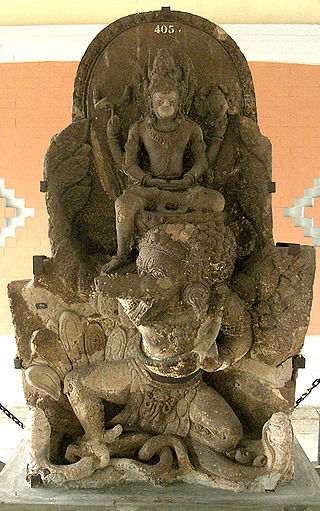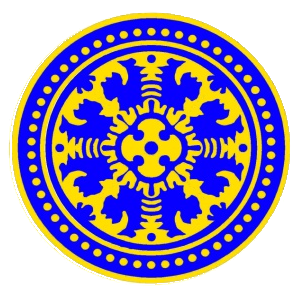

The Warmadewa dynasty, also Varmadeva dynasty, was a regnal dynasty in the island of Bali.


The Warmadewa dynasty, also Varmadeva dynasty, was a regnal dynasty in the island of Bali.
There is little explicit information about how the various monarchs called Warmadewa were related to each other. The term "dynasty", in this context, therefore refers generally to a group of monarchs who share a common element in their titles, rather than a hereditary lineage.
It is believed that the dynasty was founded by Sri Kesari Warmadewa in the 10th century. However, the only evidence for this claim is that Sri Kesari is the first Balinese king to use the name Warmadewa, on the Belanjong pillar (B.13). There is no explicit evidence that Sri Kesari founded the Warmadewa dynasty, only that he is the earliest known member of it. Only the part Śri Kesarī Warma- of this name is clearly visible on the stone, but it is conjectured that the final element -dewa was written there but is now illegible.
The dynasty prospered for several generations. The final ruler to use the title Warmadewa was the famous king Udayana Warmadewa, in the Abang Pura Batur A inscription dated 6 April 1011. [1] Udayana Warmadewa is believed by many historians to be the father of Airlangga, the famous king of Java in the 1020s to 1040s, on the basis of Airlangga's biography given in the Pucangan inscription (1041).

The 10th century was the period from 901 through 1000 (M) in accordance with the Julian calendar, and the last century of the 1st millennium.

The Shailendra dynasty was the name of a notable Indianised dynasty that emerged in 8th-century Java, whose reign signified a cultural renaissance in the region. The Shailendras were active promoters of Mahayana Buddhism and covered the Kedu Plain of Central Java with Buddhist monuments, one of which is the colossal stupa of Borobudur, now a UNESCO World Heritage Site.

The Mataram Kingdom ; also known as Medang Kingdom was a Javanese Hindu–Buddhist kingdom that flourished between the 8th and 11th centuries. It was based in Central Java, and later in East Java. Established by King Sanjaya, the kingdom was ruled by the Shailendra dynasty and Ishana dynasty.
Dharmawangsa, stylized regnal name Sri Maharaja Isyana Dharmawangsa Teguh Anantawikramottunggadewa of the Isyana dynasty, was the last raja of the Kingdom of Mataram, who reigned from 990 to 1016 CE. He also known by his posthumous name Wijayamreta Wardhana, which means "powerful in glorious death", which refer to his fight to the death.

Airlangga, regnal name Rakai Halu Sri Lokeswara Dharmawangsa Airlangga Anantawikramottunggadewa, was the only raja of the Kingdom of Kahuripan.

Udayana University is a for-profit public university in Denpasar, Bali, Indonesia. It was established on September 29, 1962 and it used to belong to the Airlangga University that mainly located in Surabaya. Its current rector is I Nyoman Gde Antara. The university's name was derived from the 10th century Balinese King Udayana (Dharmodayana) of the Warmadewa Dynasty.

The History of Bali covers a period from the Paleolithic to the present, and is characterized by migrations of people and cultures from other parts of Asia. In the 16th century, the history of Bali started to be marked by Western influence with the arrival of Europeans, to become, after a long and difficult colonial period under the Dutch, an example of the preservation of traditional cultures and a key tourist destination.

Sri Kesari Warmadewa was the first king of Bali whose name is recorded in a written inscription. He was the issuing authority for four inscriptions, including the famous 914 CE inscription on the Belanjong pillar in southern Sanur.
Udayana Warmadewa, also Dharmmodayana Warmadewa, was a king of the island of Bali in the 10th century. He belongs to the Warmadewa dynasty. He was married to the Javanese queen Mahendradatta, also known as Gunapriyadharmapatni. Their son was the famous Airlangga, who replaced the overthrown emperor of Java Dharmawangsa, and ruled in both Java and his original home of Bali.

The Belanjong pillar, also Blanjong pillar or Blanjong inscription, is a pillar established in 914 CE in the harbour of Belanjong, in the southern area of Sanur in Bali.
Mahendradatta, also known as Gunapriya Dharmapatni, was the queen of Bali, the queen consort of Udayana Warmadewa, also popularly known as King Udayana from Warmadewa dynasty. She was also the mother of Javanese hero-king Airlangga. Her other younger sons are Marakata and Anak Wungçu.

Kahuripan was an 11th-century Javanese Hindu-Buddhist kingdom with its capital located around the estuarine of Brantas River valley in East Java. The kingdom was short-lived, only spanning the period between 1019 and 1045, and Airlangga was the only raja of the kingdom, which was built out of the rubble of the Kingdom of Mataram after the Srivijaya invasion. Airlangga later in 1045 abdicated in favour of his two sons and divided the kingdom into Janggala and Panjalu (Kadiri). The kingdom's name derived from Old Javanese term hurip with circumfix ka- -an which means "life" or "livelihood". Later in 14th to 15th century, the former kingdom was recognised as one of Majapahit's 12 provinces.

The Kingdomship of Bali was a series of Hindu-Buddhist kingdoms that once ruled some parts of the volcanic island of Bali, in Lesser Sunda Islands, Indonesia. With a history of native Balinese kingship spanning from the early 10th to early 20th centuries, Balinese kingdoms demonstrated sophisticated Balinese court culture where native elements of spirit and ancestral reverence combined with Hindu influences – adopted from India through ancient Java intermediary – flourished, enriched and shaped Balinese culture.
Sri Makutawangsa Wardhana was the king of Mataram Kingdom, in East Java, that ruled prior to 990s CE. He was the son and the successor of Queen Isyana Tunggawijaya and King Sri Lokapala. He belongs to the Isyana dynasty, established by his grandfather, Mpu Sindok that ruled Java circa the 10th century CE.
Śri Ajñadewi was a reigning queen of Bali, who flourished in 1016 CE.
Sang Ratu Aji Tabanendra Warmadewa was a king from the Warmadewa dynasty, who is thought to have ruled in Bali between 877-889 Saka. His name is mentioned on three inscriptions in Manik Liu village, dated the 1st of Srawana month in the year of 877 Saka; and in another inscription in Kintamani village, dated the 6th of Bhadrapada month, Suklapaksa in the year of 889 Saka.
Sang Ratu Sri Janasadhu Warmadewa was a king of the Warmadewa dynasty, who ruled Bali around the end of the 10th century CE. Based on various inscriptions, he was the fifth king of the dynasty. King Janasadhu's name has been found in only one inscription, namely the Sembiran inscription, which was dated to 897 Saka.
Makata Pangkaja was a Balinese king from the Warmadewa dynasty.
Sang Ratu Sri Ugrasena was a Balinese king who is thought to have ruled between 837-864 Saka, or 915-942 CE. The capital of his kingdom was in Singhamandawa. The king issued several inscriptions regarding various activities of his people, including the giving of royal endowment, tax regulation, religious ceremony, and construction of public lodge and place of worship for pilgrims. His reign was approximately the same period as King Sindok's of the Isyana dynasty in East Java.